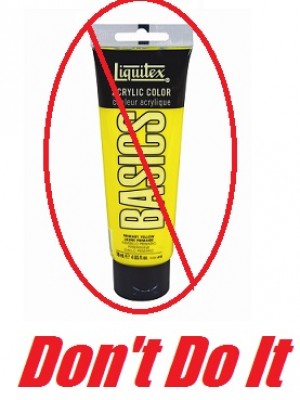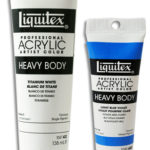As a painter I am often asked what medium is “harder” or which do I like more.
I definitely have a preference for acrylics, but this doesn’t mean I’m not constantly playing with other media (as evidenced by the body of my work). Acrylics are what I was taught to use and were handy to take with me whenever I moved during the years I spent in college. The years that acrylics and I have had together make them more familiar. My teacher, Ms. Dona, was trained with oils. The way she taught me to paint gives my work the look of being done in oil, even when it isn’t, simply because of how I was instructed to do my brushwork and apply color.
There are people out there who might view oil as being “superior” to acrylic, which is an interesting way to look at it. Oil has been used for a couple hundred years longer than acrylic and does behave differently, but it’s all apples to oranges for me. I select what I paint with (oil, acrylic, watercolour) based upon the needs of what I am painting and not because I’ve decided one medium is “better” than another.
Oil verse Acrylic. Oil can be more forgiving than acrylic. With acrylics I am used to the time-sensitive nature of it. The paint dries quickly! Be prepared for what you’re about to do twelve steps in advance because you’re about to do all of them. With oil, be prepared for the first 1-3 steps you plan to do for a painting because there will be an extensive dry time. In my opinion, oil does have a richer color that is more effortless but not entirely impossible to reach using acrylics. Oil is also more expensive… it can be anywhere from $7-$80 per tube of paint, based upon hue and quality (for instance, purple is a difficult color to manufacture so a *good* one is more expensive than a yellow, blue or green). Acrylics are generally all within the $6-$20 range. Also, acrylics only require water and cloths for clean up (but if it dries, whatever it dries on is ruined). Oil requires turpentine (but you can work oils out of stuff with enough turpentine and patience). How the paint “moves” is also different. Oil paint is a little more slick because of its slower dry time… you can expedite this using mediums such as Japan drier, but you run the risk of the paint cracking from being forced to dry too quickly. Also, for those who may be very new or inexperienced to the world of oil verse acrylic you cannot mix these paints, brushes or cleaning clothes because oil and water (acrylic is water based) don’t mix. If you do force them to mix they will eventually separate, despite your best efforts. The painting won’t have much longevity to it. What you CAN do, though, is paint using acrylic as a sketch or skeleton for the painting, let it dry completely, then paint over it in oil. You cannot do it the other way around. Acrylics are like plastic, they will create a coat over the oil and prevent it from drying properly. If you want to go traditional, your sketch should be in oil or charcoal, not acrylic or pencil (the graphite that is in a pencil can reflect through your lighter pigment paints, such as white or yellow).
… I could go on for paragraphs about the nuances between them but I think I’ve covered the largest, most basic differences in what affects my selection.
There is always the “mixed media” aspect of my work, which is something that is precarious and difficult to describe. If you are going to play with mixed medium… anything oily, stick to oils. Anything that could be considered water-based, stick with acrylics. To summarize it quickly… I get an idea and I go for it.
If the medium isn’t something that changes the outcome of what I am painting, I will usually select acrylic paint for my work. I recommend using Winsor and Newton or Grumbacher. Liquitex isn’t bad so long as you select something that is “heavy body” (meaning more pigments present in the paint). The Liquitex Basics are not good paints even if you are learning (you may save your money but not your sanity). In many ways I find using paints which are that sub-par to be damaging to a new artist because they are so frustrating to work with. It takes 5 coats being painted and drying instead of 1-2 to get the same brightness or intended color. With someone who is already struggling with the difficulty of learning to paint… also giving them the frustration of thin paints could be enough to make them feel like painting is just a ridiculous endeavor. The Liquitex heavy body is a good monetary compromise and I still occasionally purchase those paints because they have provided me excellent color.
For whatever it’s worth, those are some of my thoughts on oils and acrylics.




